
Horton Plains National Park is a protected area in the central highlands of Sri Lanka and is covered by montane grassland and cloud forest. This plateau at an altitude of 2,100–2,300 metres (6,900–7,500 ft) is rich in biodiversity and many species found here are endemic to the region. This region was designated a national park in 1988. It is also a popular tourist destination and is situated 8 kilometres (5.0 mi) from Ohiya, 6 kilometres (3.7 mi) from the world-famous Ohiya Gap/Dondra Watch and 32 kilometres (20 mi) from Nuwara Eliya.

Hydrilla (waterthyme) is a genus of aquatic plant, usually treated as containing just one species, Hydrilla verticillata, though some botanists divide it into several species. It is native to the cool and warm waters of the Old World in Asia, Africa and Australia, with a sparse, scattered distribution; in Australia from Northern Territory, Queensland, and New South Wales.
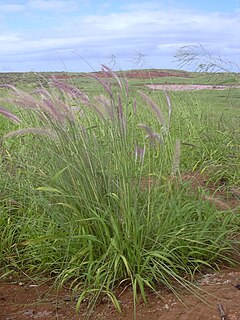
Pennisetum setaceum, commonly known as crimson fountaingrass, is a C4 perennial bunch grass that is native to open, scrubby habitats in East Africa, tropical Africa, Middle East and SW Asia. It has been introduced to many parts of the world as an ornamental plant, and has become an invasive species in some of them. It is drought-tolerant, grows fast, reaches 3 feet in height, and has many purple, plumose flower spikes.

Pennisetum is a widespread genus of plants in the grass family, native to tropical and warm temperate regions of the world. They are known commonly as fountaingrasses

Prosopis juliflora is a shrub or small tree in the family Fabaceae, a kind of mesquite. It is native to Mexico, South America and the Caribbean. It has become established as an invasive weed in Africa, Asia, Australia and elsewhere. It is a contributing factor to continuing transmission of malaria, especially during dry periods when sugar sources from native plants are largely unavailable to mosquitoes.

Annona glabra is a tropical fruit tree in the family Annonaceae, in the same genus as the soursop and cherimoya. Common names include pond apple, alligator apple, swamp apple, corkwood, bobwood, and monkey apple. The tree is native to Florida in the United States, the Caribbean, Central and South America, and West Africa. It is common in the Everglades. The A. glabra tree is considered an invasive species in Sri Lanka and Australia. It grows in swamps, is tolerant of saltwater, and cannot grow in dry soil.
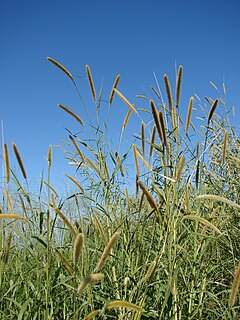
Pennisetum purpureum, also known as Napier grass, elephant grass or Uganda grass, is a species of perennial tropical grass native to the African grasslands. It has low water and nutrient requirements, and therefore can make use of otherwise uncultivated lands. Historically, this wild species has been used primarily for grazing; recently, however, it has been used as part of a push–pull agricultural pest management strategy. This technique involves the desired crop being planted alongside a 'push' plant, which repels pests, in combination with a 'pull' crop around the perimeter of the plot, which draw insects out of the plot. Napier grass has shown potential at attracting stemborer moths away from maize and hence is the "pull" crop. This strategy is much more sustainable, serves more purposes and is more affordable for farmers than insecticide use. In addition to this, Napier grasses improve soil fertility, and protect arid land from soil erosion. It is also utilized for firebreaks, windbreaks, in paper pulp production and most recently to produce bio-oil, biogas and charcoal.
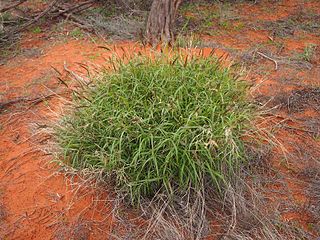
Cenchrus ciliaris is a species of grass native to most of Africa, southern Asia, southern Iran, and the extreme south of Europe (Sicily). Other names by which this grass is known include dhaman grass, anjan grass and koluk katai.

Ehrharta erecta is a species of grass commonly known as panic veldtgrass. The species is native to Southern Africa and Yemen. It is a documented invasive species in the United States, New Zealand, Australia, southern Europe, and China.

Mimosa pigra, commonly known as the giant sensitive tree,, is a species of the genus Mimosa, in the family Fabaceae. It is native to the Neotropics, but has been listed as one of the world's 100 worst invasive species and forms dense, thorny, impenetrable thickets, particularly in wet areas.
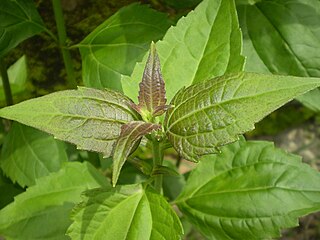
Chromolaena odorata is a tropical and subtropical species of flowering shrub in the sunflower family. It is native to the Americas, from Florida and Texas in the United States south through Mexico and the Caribbean to South America. It has been introduced to tropical Asia, west Africa, and parts of Australia.

The tropical grass species Pennisetum clandestinum is known by several common names, most often kikuyu grass, as it is native to the region of East Africa that is home to the Kikuyu people. Because of its rapid growth and aggressive nature, it is categorised as a noxious weed in some regions. However, it is also a popular garden lawn species in Australia, New Zealand, South Africa and the southern region of California in the United States, as it is inexpensive and drought-tolerant. In addition, it is useful as pasture for livestock grazing and serves as a food source for many avian species, including the long-tailed widowbird. The flowering culms are very short and "hidden" amongst the leaves, giving this species its specific epithet (clandestinum).

Aristida behriana is a native Australian species of grass commonly known as bunch wire grass or brush wire grass. It is a bright green perennial plant forming short, tufted tussocks up to 40 centimetres (16 in) high. Its seeds have three long, radiating awns; it is a member of genus Aristida, grasses known commonly as three-awns. The species favours low fertility and well-drained soils. It is commonly found in mallee woodlands and plains, where it grows on sunny slopes. Superficially, the flower heads resemble those of the invasive weed African feather-grass. A. behriana is found in all mainland Australian States.

Ageratina adenophora, commonly known as crofton weed or sticky snakeroot, is a species of flowering plant in the daisy family native to Mexico and Central America. Originally grown as an ornamental plant, it has become invasive into farmland and bushland worldwide. It is toxic to horses, who develop respiratory disease after eating it.

Ehrharta calycina is a species of grass known by the common names perennial veldtgrass and purple veldtgrass.

Megathyrsus maximus, known as Guinea grass and green panic grass in English, is a large perennial bunch grass that is native to Africa, Palestine, and Yemen. It has been introduced in the tropics around the world. Until 2003, it was named Urochloa maxima. It was moved to genus Megathyrsus, which it shares with one other species, M. infestus.

{{taxobox |image =Aristea ecklonii-BSI-yercaud-salem-India.JPG |regnum =Plantae |unranked_divisio =Angiosperms |unranked_classis =Monocots |ordo =Asparagales |familia =Iridaceae |subfamilia=Aristeoideae |genus =Aristea |species=A. ecklonii |binomial=Aristea ecklonii |binomial_authority =Baker 1877 |synonyms_ref= |synonyms=*Aristea dichotomaEckl. ex Klatt 1866 not (Thunb.) Ker Gawl. 1827
The mission of Arizona Native Plant Society (AZNPS) is to promote knowledge, appreciation, conservation and restoration of Arizona native plants and their habitats, as well as the use of native plants in urban landscapes and gardens. Among its initiatives are the Plant Atlas Project of Arizona (PAPAZ), which trains AZNPS volunteers in botanical fieldwork; publication of booklets and brochures promoting the use of native plants; compilation and web publication of plant lists for various natural areas of Arizona and northern Mexico; grants for publication assistance and research; and pioneering work in invasive species education and removal.
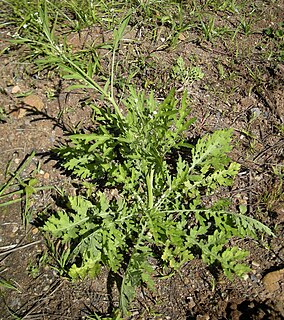
Parthenium hysterophorus is a species of flowering plant in the aster family, Asteraceae. It is native to the American tropics. Common names include Santa-Maria, Santa Maria feverfew, whitetop weed, and famine weed. In India, it is locally known as carrot grass, congress grass or Gajar Ghans. It is a common invasive species in India, Australia, and parts of Africa. The pollen grains of Parthenium hysterophorus

Digitaria ciliaris is a species of grass known by the common names southern crabgrass, tropical finger-grass, tropical crabgrass or summer grass.



















